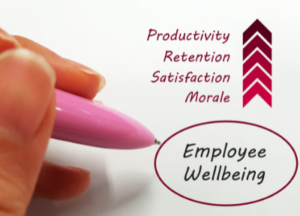
by admin | Mar 21, 2022 | Health & Wellness, Human Resources, Workplace
 Question
Question
We’ve been both super busy and understaffed recently. Is there anything we can do during this time to help our employees avoid extra stress or burnout before we can hire more employees?
Answer
Yes. Here are a few things you can do to make this time run as smoothly and stress-free as possible:
Remove nonessential work duties: For the positions that seem most stretched, make a list of tasks that could be put on hold (or perhaps reassigned). You can invite input from employees, too, but I’d recommend acknowledging that they’re overwhelmed and saying that you’ll do your best to alleviate some of the pressure. Then hold off on nonessential tasks until business slows down or you’ve increased your headcount.
Allow for flexible scheduling: If employees need to work longer hours on some days during the week, consider allowing them to work fewer hours on other days of the week. Note that some states have daily overtime, spread-of-hours, or split-shift laws.
Budget for overtime: Employees may need to work extra hours to keep up with the current demands of their job, so allow them to work overtime if you (and they) can swing it. If you’re pretty sure overtime will be necessary, inform employees of that ahead of time, so they can plan accordingly.
Ensure all equipment is fast and reliable: It’s important to identify, troubleshoot, and correct any slow or nonworking equipment issues (such as laptops, internet hardware, cash registers, or vehicles). If not resolved, these issues can slow down work and add to everyone’s stress.
Look for ways to automate: Consider whether any of your employees’ manual and time-consuming tasks could be eliminated or simplified with the use of new or different technology.
Increase safety protocols: Employee absences related to COVID have created a significant strain for many employers during the pandemic. Shoring up your safety protocols may reduce the risk of COVID-related absences because of sickness or exposure. Depending on your circumstances, examples include improving ventilation, encouraging or requiring vaccination, requiring employees to wear masks, and allowing employees to work remotely when possible.
By Megan Lemire
Originally posted on Mineral

by admin | Feb 14, 2022 | Health & Wellness
 February is American Heart Month, a time when all people can focus on their cardiovascular health. Do you know how to keep your heart healthy? You can take an active role in reducing your risk for heart disease by eating a healthy diet, engaging in physical activity, and managing your cholesterol and blood pressure.
February is American Heart Month, a time when all people can focus on their cardiovascular health. Do you know how to keep your heart healthy? You can take an active role in reducing your risk for heart disease by eating a healthy diet, engaging in physical activity, and managing your cholesterol and blood pressure.
Heart disease accounts for nearly one-third of all deaths worldwide. Studies and experts recommend exercise as an important way to maintaining a healthy heart, but your diet plays a major role in heart health and can impact your risk of heart disease. The most important factor in healthy eating is having a balanced diet, watching portions, and eating foods you actually enjoy. This will allow you to stick with it for the long term.
Let’s take a closer look at the 4 key factors for a heart healthy diet and examples of how you can incorporate them into your daily life:
1. Fruits and Vegetables:
Leafy green vegetables are well known for their wealth of vitamins, minerals, and antioxidants. An analysis of eight studies found that increasing leafy green vegetable intake was associated with up to a 16% lower incidence of heart disease.

2. Healthy Proteins:
Lean meat, poultry and fish, low-fat dairy products and eggs are some of your best sources of protein. Legumes – beans, peas and lentils – are good, low-fat sources of protein and are a good substitute for meat. Also, substituting plant protein for animal protein – ie. a black bean burger for a hamburger – will reduce your fat & cholesterol intake and increase your fiber intake.

3. Healthy Fats:
Not all fats are bad. Foods with monounsaturated and polyunsaturated fats are important for your brain and heart. Limit foods with trans-fats, which increase the risk for heart disease.

4. Whole Grains:
Whole grains are good sources of fiber and other nutrients that play a role in regulating blood pressure and heart health.

Eating heart healthy is a lifestyle, it’s about nutrition, balance and retraining our mind to make better food choices. What you eat can influence almost every aspect of heart health, from blood pressure and inflammation to cholesterol levels and triglycerides. A well-balanced diet can help keep your heart in good shape and minimize your risk of heart disease. With planning and a few simple substitutions, you can eat with your heart in mind!

by admin | Feb 9, 2022 | Health & Wellness
 Workplace wellness programs have increased in the past several years to promote healthy diets and lifestyle, exercise and other behaviors such as quitting smoking. As of 2020, most employers had wellness programs of some kind, including 53% of small firms (those with 3-200 employees) and 81% of large companies. Since employees spend most of their waking hours on the job, wellness programs seem to be a natural fit to try to promote healthy changes in behavior. But, in 2022, employees want more; many workers are looking for employers who show authentic concern for their well-being.
Workplace wellness programs have increased in the past several years to promote healthy diets and lifestyle, exercise and other behaviors such as quitting smoking. As of 2020, most employers had wellness programs of some kind, including 53% of small firms (those with 3-200 employees) and 81% of large companies. Since employees spend most of their waking hours on the job, wellness programs seem to be a natural fit to try to promote healthy changes in behavior. But, in 2022, employees want more; many workers are looking for employers who show authentic concern for their well-being.
Well-being is about how our lives are going. It’s not only about health and happiness but also about living life to its fullest potential. In fact, data shows that employees of all generations rank “the organization cares about the employees’ well-being” in their top three criteria.
Financial stress soared during the pandemic but so did regular stress, too. Mental health struggles such as anxiety, depression, and substance abuse are also climbing. These are expensive issues to ignore both in terms of the human suffering but also the company’s bottom line: Depression alone costs an estimated $210.5 billion per year. These costs are due to absenteeism (missed work days) and presenteeism (reduced productivity at work) as well as direct medical costs (outpatient and inpatient medical services and pharmacy costs).
Employers must recognize the interrelationship between the physical, financial, work and well-being components of employees’ lives. For example, employees who need help with their financial well-being are significantly less likely to be physically healthy and more likely to report feeling stressed or anxious which can impact productivity and job performance. Vice President for Communications at Fidelity Investments in Boston, Mike Shamrell, recognizes the need for all dimensions of wellness. “It’s tough to be well in one area when you’re unwell in another,” he said.
Well-being is often associated with gym memberships and green smoothies but it is much more than that; it is a result of many different aspects of one’s life. Here are 5 common dimensions of well-being that can be addressed through a workplace wellness program:
- Emotional/Mental Health – Understanding your feelings and coping with stress.
- Physical Health – Discovering how self-care can improve your life and productivity.
- Financial Health – Successfully managing your money.
- Social Connectedness – Creating and being a part of a support network.
- Occupational Well-Being– Feeling appreciated at work and satisfied in your contributions.
Great employees want great employers. Companies that want creative, high-performing teams must be willing to support workers both in and out of the office. Well-being has a major influence on an employee’s performance and satisfaction; employees who feel valued and appreciated are more invested in their company in return.

by admin | Feb 1, 2022 | Health & Wellness
 While the new year feels like a fresh start for most workers, it’s also expected to come with a spike in health insurance premiums. Premiums and deductibles have been steadily increasing for years. The Kaiser Family Foundation (KFF) found that premiums for a family rose 4% in 2021, according to a survey focused on employer-sponsored benefits.
While the new year feels like a fresh start for most workers, it’s also expected to come with a spike in health insurance premiums. Premiums and deductibles have been steadily increasing for years. The Kaiser Family Foundation (KFF) found that premiums for a family rose 4% in 2021, according to a survey focused on employer-sponsored benefits.
The average family pays $22,221 in premiums, according to KFF. Workers contributed $5,969 toward their coverage, while employers paid the rest. In fact, since 2011 the average family premiums have increased 47%, which KFF found was more than wages (31%) and inflation (19%).
Not only is this a financial hardship for American families, but it’s also draining companies that are struggling to maintain employee coverage. To complicate the matter, several federal programs providing support for healthcare are due to expire in 2022.
What to Expect in Healthcare Coverage
Rising healthcare premiums are only part of the problem. Deductibles are also skyrocketing. This is the amount workers have to pay before insurance kicks in and could make a huge financial difference for families dealing with a serious health issue.
The average single deductible has doubled in the last decade to $1,669. For the more affordable healthcare plans, deductibles can be as high as $8,000. Overall, 85% of the 155 Americans with employer-sponsored coverage have a deductible.
Another survey conducted by the Business Group on Health anticipates healthcare costs increasing by as much as 6% in 2022. Analysts pointed out that 2021 rates actually flattened out slightly because many Americans avoided treatments during the pandemic. That’s expected to end in 2022, which will drive up prices. Of all employers surveyed by BGOH, 94% expected higher medical costs because of delays in treatment.
Expiring Federal Support Programs
Federal legislation is also expiring in January 2022. The Coronavirus Aid, Relief, and Economic Security (CARES) Act was one of the first bills signed in 2020 to help workers. It gave money to businesses, enhanced unemployment programs, and funded hospitals.
One provision known as “safe harbor” allowed high-deductible health plans to cover telehealth and remote care services at little to no cost. The CARES act expired on December 31 and will now impact who is eligible for telehealth services.
Another rule under the American Rescue Plan Act (ARPA) in 2021 allowed for mid-year election changes for Dependent Care Reimbursement Accounts (DCRA). This allowed workers to elect higher limits to help pay for childcare pre-tax. The ARPA also expires on December 31. If the new higher exclusion limit is not extended into 2022, families will have to contend with the previous $5,000 limit.
Around 30 million Americans get their health coverage from the Marketplace, which was established by the Affordable Care Act. With more enrollees and more available plans in 2022, experts anticipate a change in premium subsidies that could increase the total price people have to pay.
Navigating the Future
Regardless of what employers decide to do, HR departments need to be proactive in guiding employees through the process. Healthcare decisions are complex and no company wants disgruntled workers as a result of cutting or switching plans without notice. Clear communication and assistance are necessary to ensure a smooth transition that is beneficial for everyone.
Companies and HR departments should also keep in mind that the benefits they ultimately choose will define future recruiting. Healthcare benefits are a top decision-making factor for most prospects.
By Mckenzie Cassidy
Originally posted on HR Exchange Network

by admin | Jan 26, 2022 | Health & Wellness
 It can sometimes feel as if we’re bombarded with information about the latest eating trend or buzzworthy ingredient. But good nutrition is really about having a well-rounded diet, and it’s easier to do than you may think. In fact, living a nutritious lifestyle can be easy and fun.
It can sometimes feel as if we’re bombarded with information about the latest eating trend or buzzworthy ingredient. But good nutrition is really about having a well-rounded diet, and it’s easier to do than you may think. In fact, living a nutritious lifestyle can be easy and fun.
Nutrition is about more than vitamins—it also includes fiber and healthy fats. Now is a perfect time to learn simple ways to help your whole family eat healthier.
Need tips specifically for young children? Learn how to introduce kids to healthy foods.
Add healthy fats.
Not all fats are bad. Foods with monounsaturated and polyunsaturated fats are important for your brain and heart. Limit foods with trans fats, which increase the risk for heart disease. Good sources of healthy fats include olive oil, nuts, seeds, certain types of fish, and avocados.
Try this:
- Top lean meats with sliced avocado, or try some avocado in your morning smoothie.
- Sprinkle nuts or seeds (like slivered almonds or pumpkin seeds) on soups or salads.
- Add a fish with healthy fats, like salmon or tuna, into your meals twice a week.
- Swap processed oils (like canola or soybean oil) for oils that are cold-pressed, like extra-virgin olive oil and sesame oil.
Cut the sodium.
Good nutrition is about balance, and that means not getting too much of certain ingredients, such as sodium (salt). Sodium increases blood pressure, which raises the risk for heart disease and stroke. About 90% of Americans 2 years old or older consume too much sodium. For most people ages 14 years and older, sodium should not exceed 2,300 mg per day.
Try this:
- Avoid processed and prepackaged food, which can be full of hidden sodium. Many common foods, including breads, pizza, and deli meats, can be sources of hidden sodium.
- At the grocery store, look for products that say “low sodium.”
- At restaurants, ask for sauces and dressings on the side. Get more tips for lowering sodium while eating out.
- Instead of using salt, add delicious flavor to your meals with a squeeze of fresh lemon juice, a dash of no-salt spice blends, or fresh herbs.
Bump up your fiber.
Fiber in your diet not only keeps you regular, it also helps you feel fuller longer. Fiber also helps control blood sugar and lowers cholesterol levels.3,4 Fresh fruits and vegetables, whole grains, and legumes (beans and peas) are good sources of fiber.
Try this:
- Slice up raw veggies and keep them in to-go baggies to use as quick snacks.
- Start your day off with a high-fiber breakfast like whole grain oatmeal sprinkled with pecans or macadamia nuts.
- Steam veggies rather than boiling them. When buying frozen veggies, look for ones that have been “flash frozen.”
- Add half a cup of beans or peas to your salad to add fiber, texture, and flavor.
Aim for a variety of colors on your plate.
Foods like dark, leafy greens, oranges, and tomatoes—even fresh herbs—are loaded with vitamins, fiber, and minerals.
Try this:
- Sprinkle fresh herbs over a salad or whole wheat pasta.
- Make a red sauce using canned tomatoes (look for “low sodium” or “no salt added”), fresh herbs, and spices.
- Add diced veggies like peppers, broccoli, or onions to stews and omelets to give them a boost of color and nutrients.
Are you eating healthy to help you get to a healthy weight? Learn more about balanced eating.
Originally posted on Centers for Disease Control and Prevention (CDC)

by admin | Jan 11, 2022 | Health & Wellness
 Ever wonder why the resolutions you make in January don’t stick around after March? You aren’t alone! Studies show that only 8% of people keep their New Year’s resolutions. Why? And how do people achieve their goals set at New Year’s? We’ve broken it down for you so you can identify your goal-breaker as well as give you some tips on how to make those resolutions stick.
Ever wonder why the resolutions you make in January don’t stick around after March? You aren’t alone! Studies show that only 8% of people keep their New Year’s resolutions. Why? And how do people achieve their goals set at New Year’s? We’ve broken it down for you so you can identify your goal-breaker as well as give you some tips on how to make those resolutions stick.
There are three main reasons that New Year’s resolutions fail. The first goal-breaker is taking on too much (too big of a goal) and expecting it to happen too fast. Researchers have found that it takes 66 days to break a habit. That’s much higher than the previously published 21 days. It conversely means that it also takes 66 days to form a new habit. So, battle your goal-breaker by setting smaller, achievable goals to focus your energies on rather than spreading yourself too thin on lofty goals.
The second reason you fail to keep your resolution is you don’t have anyone supporting you. This could be because you simply didn’t tell anyone that you have new life goals. It could also be due to fear of accountability. You need some life-cheerleaders that root you on to victory. These cheerleaders also call you out when you are riding off the tracks. Their support isn’t tied to your achievement of your goals but instead their support is firmly tied to you and they want to see you succeed.
The last goal-breaker setting a goal that is too vague. You can’t get to your destination if you don’t know where you are going. A goal like “I want to try harder at work” or “I want to save more money this year” is too general a notion that does not give you something specific to work towards or a well-defined path to follow. And if you can’t provide specific benchmarks, you can’t measure your progress.
Now, let’s steer this ship back on course with some tips on KEEPING your New Year’s resolutions.
Plan Ahead
To ensure success, plan ahead so you can have the resources available when you need them. Then, you won’t have excuses for why you can’t follow through. Here are a few things you can do to prepare:
- Read up on it – Get books on the subject. Whether it’s taking up running or becoming a vegetarian, there are books to help you prepare for it.
- Plan for success – Get everything you need so things will go smoothly. If you are taking up running, make sure you have the clothes, shoes, and playlists so that you are ready to get started.
Reward Yourself Along the Way
Small rewards are great encouragement to keep you going during the hardest first days. After that, you can try to reward yourself once a week with a lunch with a friend, a nap, or whatever makes you tick. Later, you can change the rewards to monthly and even pick an anniversary reward!
Write Your Goals Down on Paper
Writing establishes intention but action needs to be taken to achieve your resolution. Have a written account of your goals is a constant reminder to take action. Mark Murphy says “Writing things down doesn’t just help you remember, it makes your mind more efficient by helping you focus on the truly important stuff. And your goals absolutely should qualify as truly important stuff.”
Start When You’re Ready
When you launch your resolution on January 1st, you are making a change based on a calendar date. What are the chances that you’re going to be ready for a life change at exactly the same time the calendar rolls over to a new year? There’s no need to launch your resolution on January 1st or even in January. Start working on your goal when you’re ready. That’s not to say that you need to wait until you feel fully confident before starting (that may never happen). Delaying your goal a few weeks or a few months is better than abandoning it altogether.
Identify Your Purpose
Knowing your “WHAT” (goal) is important but knowing your “WHY” can be just as important when it comes to following through on your intentions. Why do you want to lose weight in 2022? When you put the why to the what, you are truly focused on what matters. “I want to lose weight so that I can play with my children without getting tired and show them that hard work is worth it.” Now, THAT’S a great goal.
Identifying goal-breakers and goal-makers are equally important pieces to achieving what you set out to accomplish, especially with regards to New Year’s resolutions. Commit to making this year the year that your resolution is going to stick!

 Question
Question








